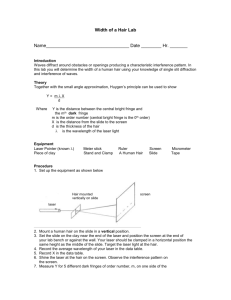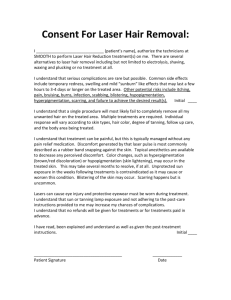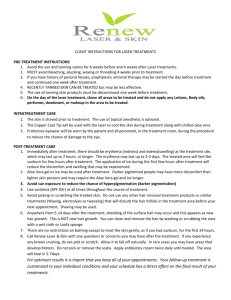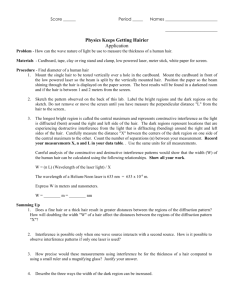Procedure (Copy from below)
advertisement
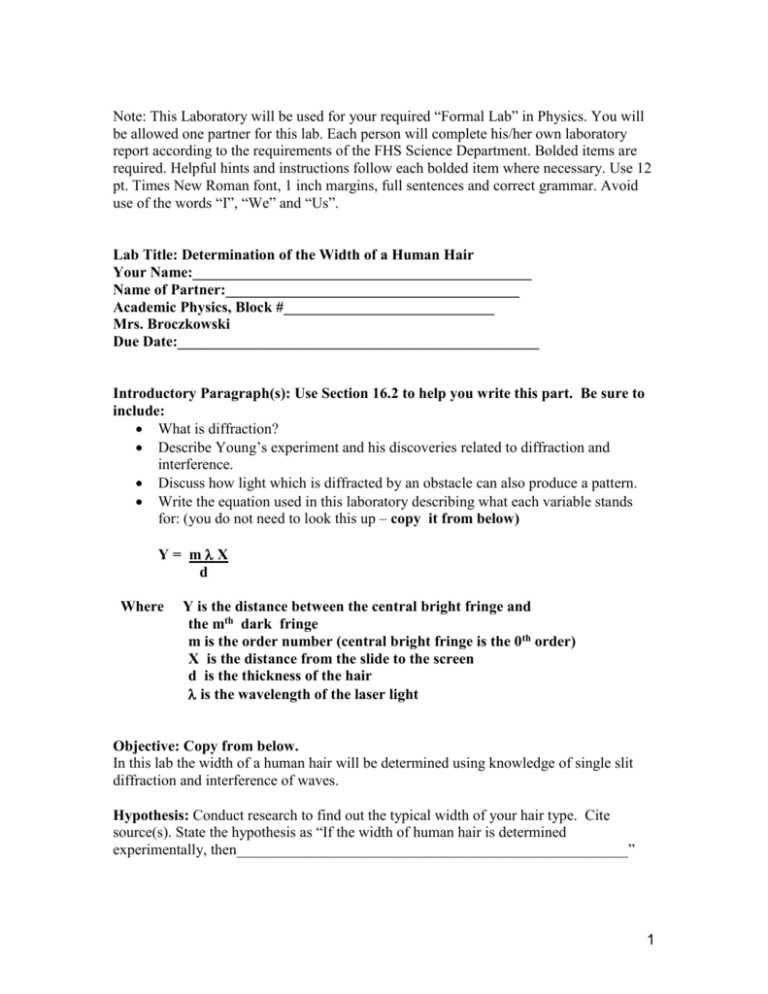
Note: This Laboratory will be used for your required “Formal Lab” in Physics. You will be allowed one partner for this lab. Each person will complete his/her own laboratory report according to the requirements of the FHS Science Department. Bolded items are required. Helpful hints and instructions follow each bolded item where necessary. Use 12 pt. Times New Roman font, 1 inch margins, full sentences and correct grammar. Avoid use of the words “I”, “We” and “Us”. Lab Title: Determination of the Width of a Human Hair Your Name:_____________________________________________ Name of Partner:_______________________________________ Academic Physics, Block #____________________________ Mrs. Broczkowski Due Date:________________________________________________ Introductory Paragraph(s): Use Section 16.2 to help you write this part. Be sure to include: What is diffraction? Describe Young’s experiment and his discoveries related to diffraction and interference. Discuss how light which is diffracted by an obstacle can also produce a pattern. Write the equation used in this laboratory describing what each variable stands for: (you do not need to look this up – copy it from below) Y= mX d Where Y is the distance between the central bright fringe and the mth dark fringe m is the order number (central bright fringe is the 0th order) X is the distance from the slide to the screen d is the thickness of the hair is the wavelength of the laser light Objective: Copy from below. In this lab the width of a human hair will be determined using knowledge of single slit diffraction and interference of waves. Hypothesis: Conduct research to find out the typical width of your hair type. Cite source(s). State the hypothesis as “If the width of human hair is determined experimentally, then____________________________________________________” 1 Materials (Copy from below) Laser Pointer (known) Piece of clay Meter stick Stand and Clamp Ruler A Human Hair Screen Slide Tape Procedure (Copy from below) 1. Set up the equipment as shown below screen Hair mounted vertically on slide laser 2. Mount a human hair on the slide in a vertical position. 3. Set the slide on the clay near the end of the laser and position the screen at the end of your lab bench or against the wall. Your laser should be clamped in a horizontal position the same height as the middle of the slide. Target the laser light at the hair. 4. Record the average wavelength of your laser in the data table. 5. Record X in the data table. 6. Shine the laser at the hair on the screen. Observe the interference pattern on the screen. 7. Measure Y for 5 different dark fringes of order number, m, on one side of the bright central fringe. Record m and Y in the data table for each dark fringe. Data/Results/Observations Quantitative Results: Copy and fill in with your data. = ___________________ X = __________________ m 1 2 3 4 5 Y (m) d (m) Average 2 Qualitative Results: Describe what you saw happen and anything that might lead to error. Analysis/Calculations: 1. Solve for d for each value of m in the data table. Record in the data table. Show an example calculation (full work) for m = 1 2. Average the five values for d and record in the table. Conclusion: Compare your value to the literature range of values for human hair. Provide a one-line sentence that supports or rejects the hypothesis Describe at least 2 possible sources of scientific error that might have occurred. Discuss what you learned from the experiment. Works Cited: List all sources of information in MLA format. Example: Kane, Joseph W. and Morton M. Sternheim.Physics. New York: John Wiley & Sons, 1984. Print 3
